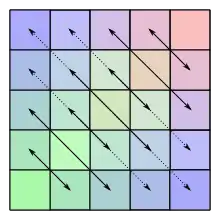In mathematics, persymmetric matrix may refer to:
- a square matrix which is symmetric with respect to the northeast-to-southwest diagonal (anti-diagonal); or
- a square matrix such that the values on each line perpendicular to the main diagonal are the same for a given line.
The first definition is the most common in the recent literature. The designation "Hankel matrix" is often used for matrices satisfying the property in the second definition.
Definition 1

Let A = (aij) be an n × n matrix. The first definition of persymmetric requires that
- for all i, j.[1]
For example, 5 × 5 persymmetric matrices are of the form
This can be equivalently expressed as AJ = JAT where J is the exchange matrix.
A third way to express this is seen by post-multiplying AJ = JAT with J on both sides, showing that AT rotated 180 degrees is identical to A:
A symmetric matrix is a matrix whose values are symmetric in the northwest-to-southeast diagonal. If a symmetric matrix is rotated by 90°, it becomes a persymmetric matrix. Symmetric persymmetric matrices are sometimes called bisymmetric matrices.
Definition 2
The second definition is due to Thomas Muir.[2] It says that the square matrix A = (aij) is persymmetric if aij depends only on i + j. Persymmetric matrices in this sense, or Hankel matrices as they are often called, are of the form
A persymmetric determinant is the determinant of a persymmetric matrix.[2]
A matrix for which the values on each line parallel to the main diagonal are constant is called a Toeplitz matrix.
See also
References
- ↑ Golub, Gene H.; Van Loan, Charles F. (1996), Matrix Computations (3rd ed.), Baltimore: Johns Hopkins, ISBN 978-0-8018-5414-9. See page 193.
- 1 2 Muir, Thomas (1960), Treatise on the Theory of Determinants, Dover Press, p. 419